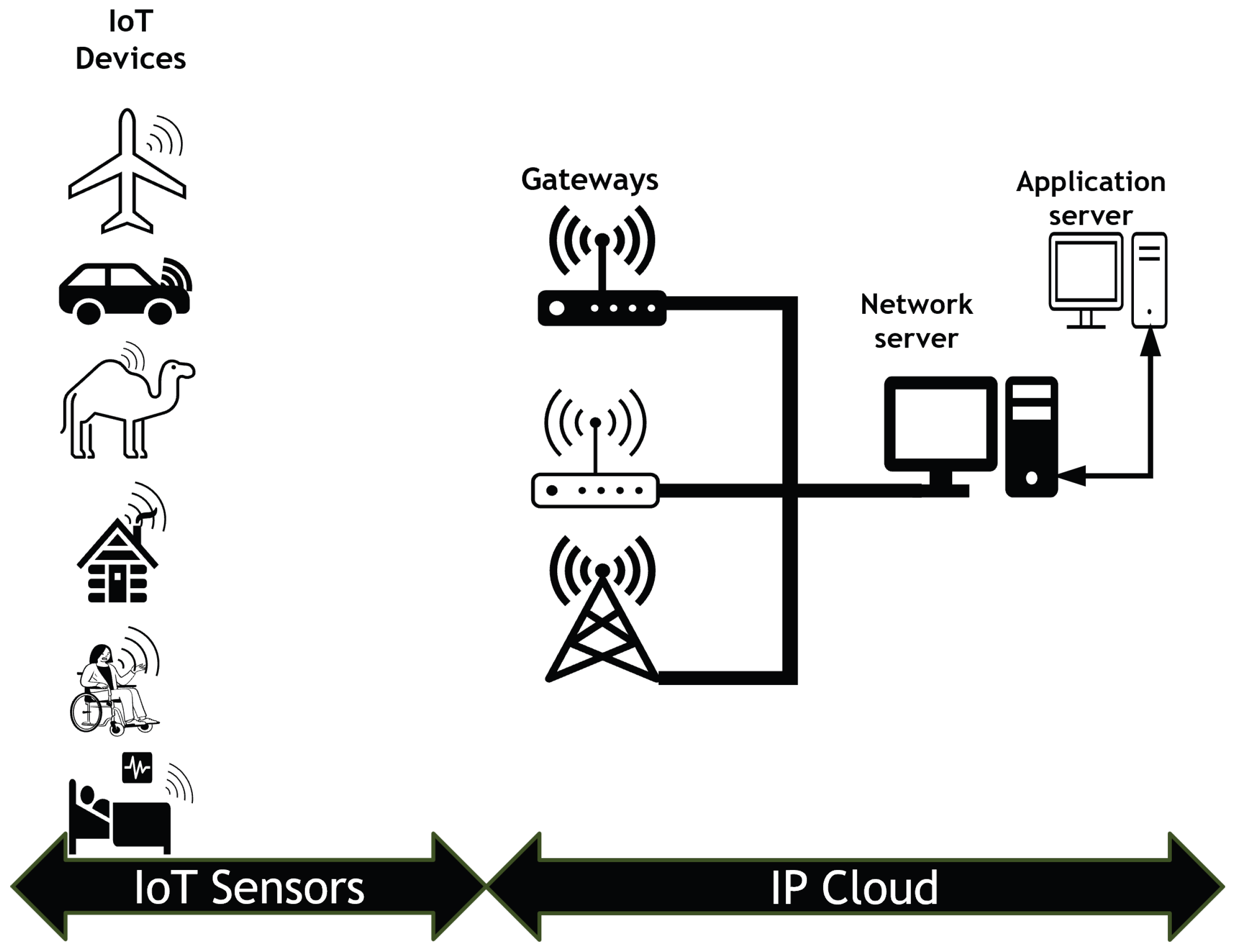ZBMG-LoRa: A Novel Zone-Based Multi-Gateway Approach Towards Scalable LoRaWANs for Internet of Things
Abstract
1. Introduction
- First contribution: Stopping the reception of packets in all gateways simultaneously prevents wasting channel availability, enabling the network server to allocate other nodes to free channels and assign them to the most suitable gateway.
- Second contribution: The paper formulates a multi-objective optimisation problem to determine the optimal ratio of nodes at each gateway and SF zone. This aims to substantially improve LoRaWAN network throughput while minimising energy consumption.
- Third contribution: Nodes are allocated to the nearest zone to meet the target ratio in a multi-gateway setup, then to the next zone, thus avoiding channel wastage and ensuring efficient configurations.
2. Related Works
2.1. LoRa/LoRaWAN

2.2. LoRaWAN Multi-Gateway
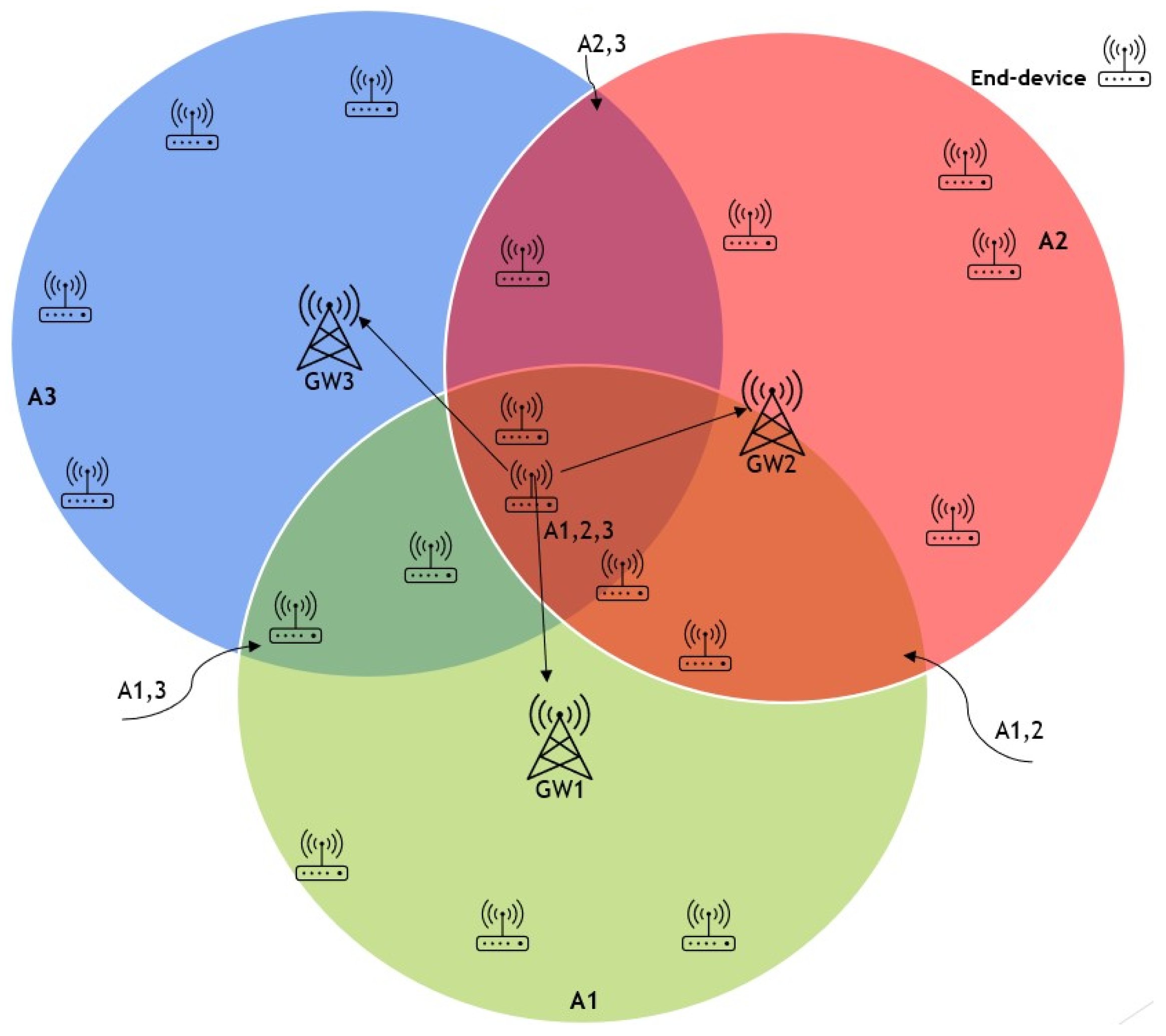
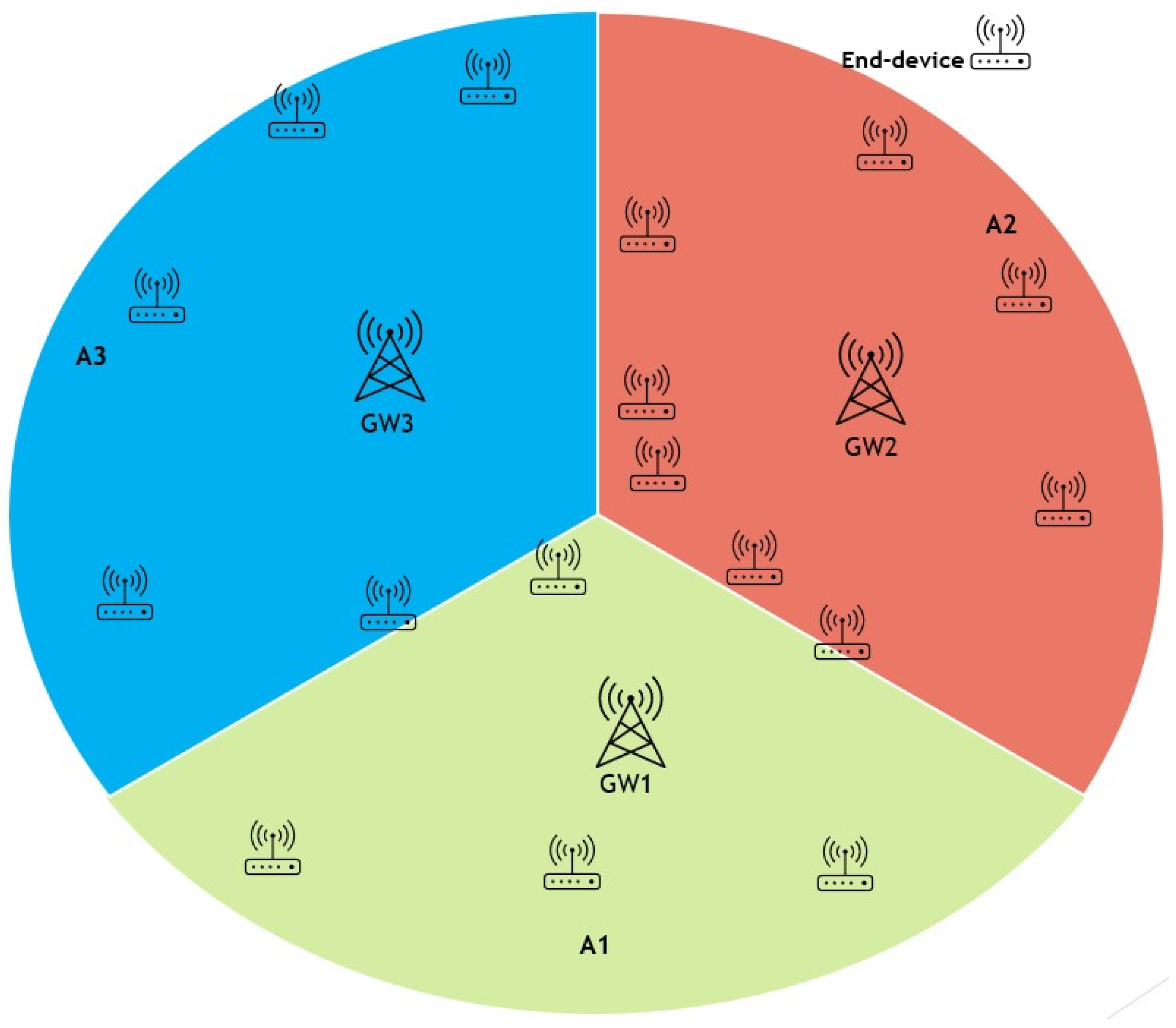
3. LoRaWAN Network System
3.1. Link Budget Model
3.2. Simulation Model
4. Zone-Based Multi-Gateway System
4.1. Adaptive Data Rate
4.2. ZBMG-LoRa System

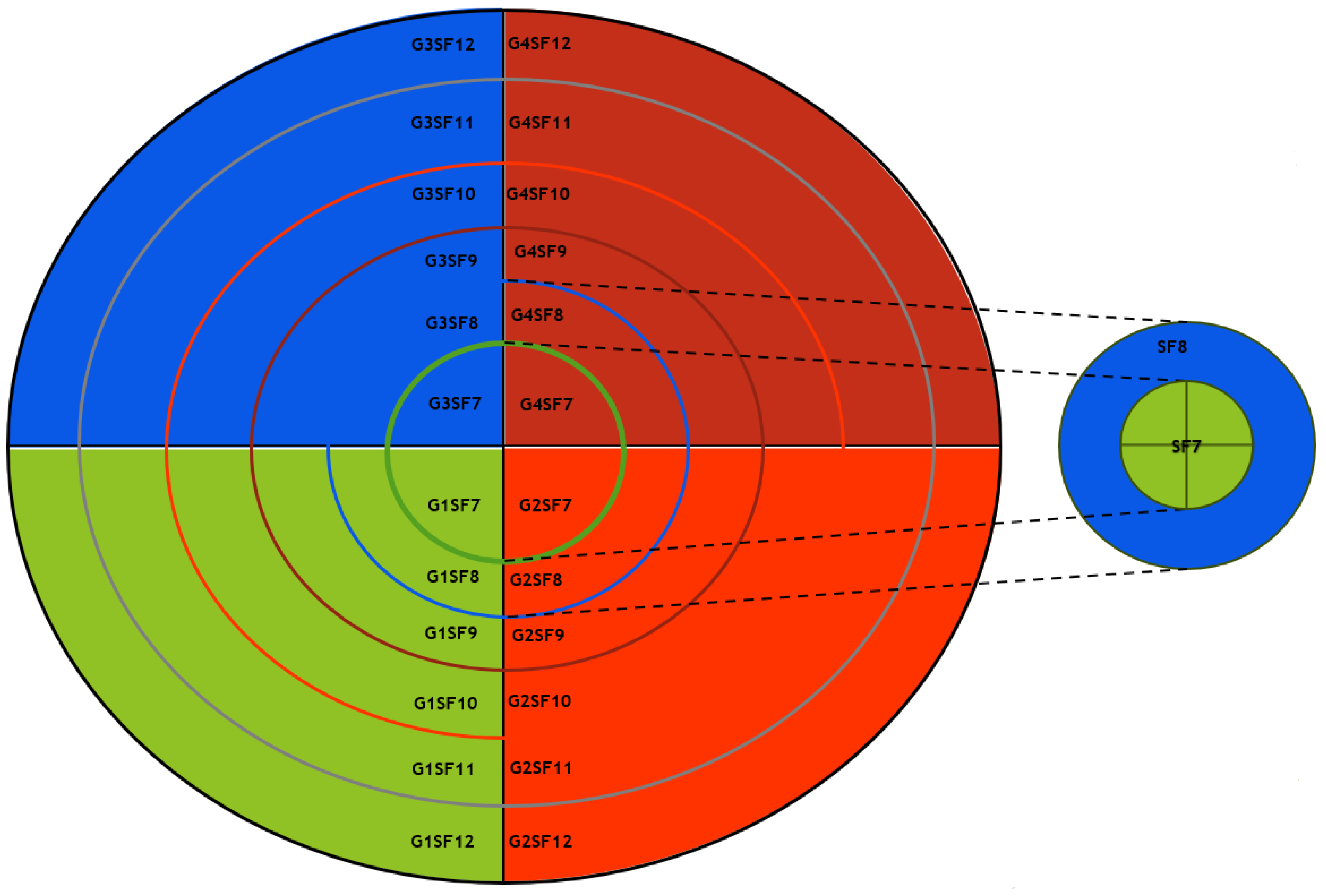
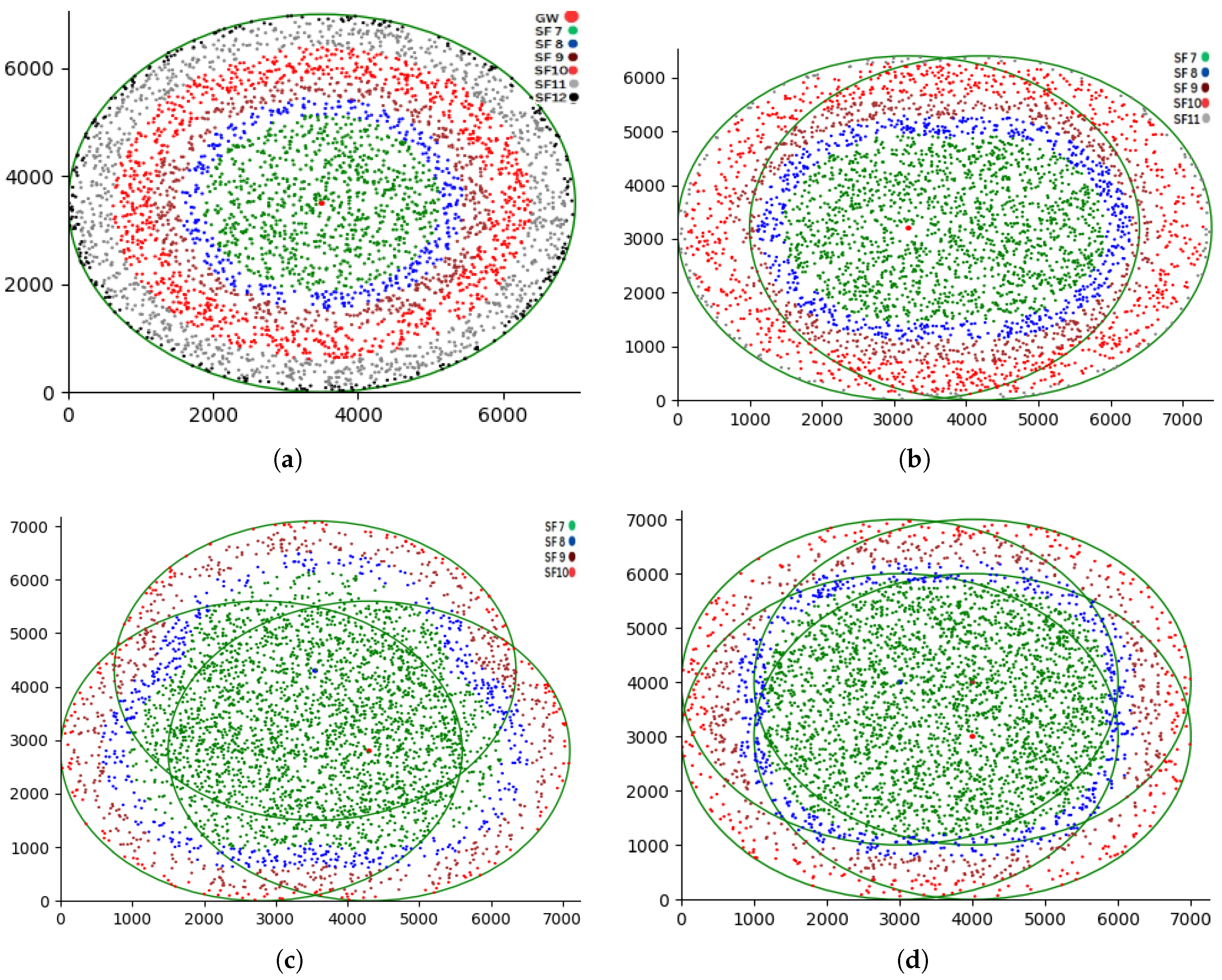
4.3. ZBMG-LoRa Algorithm
| Algorithm 1: ZBMG-LoRa Algorithm |
 |
5. Performance Evaluation
5.1. Packet Delivery Ratio (PDR)
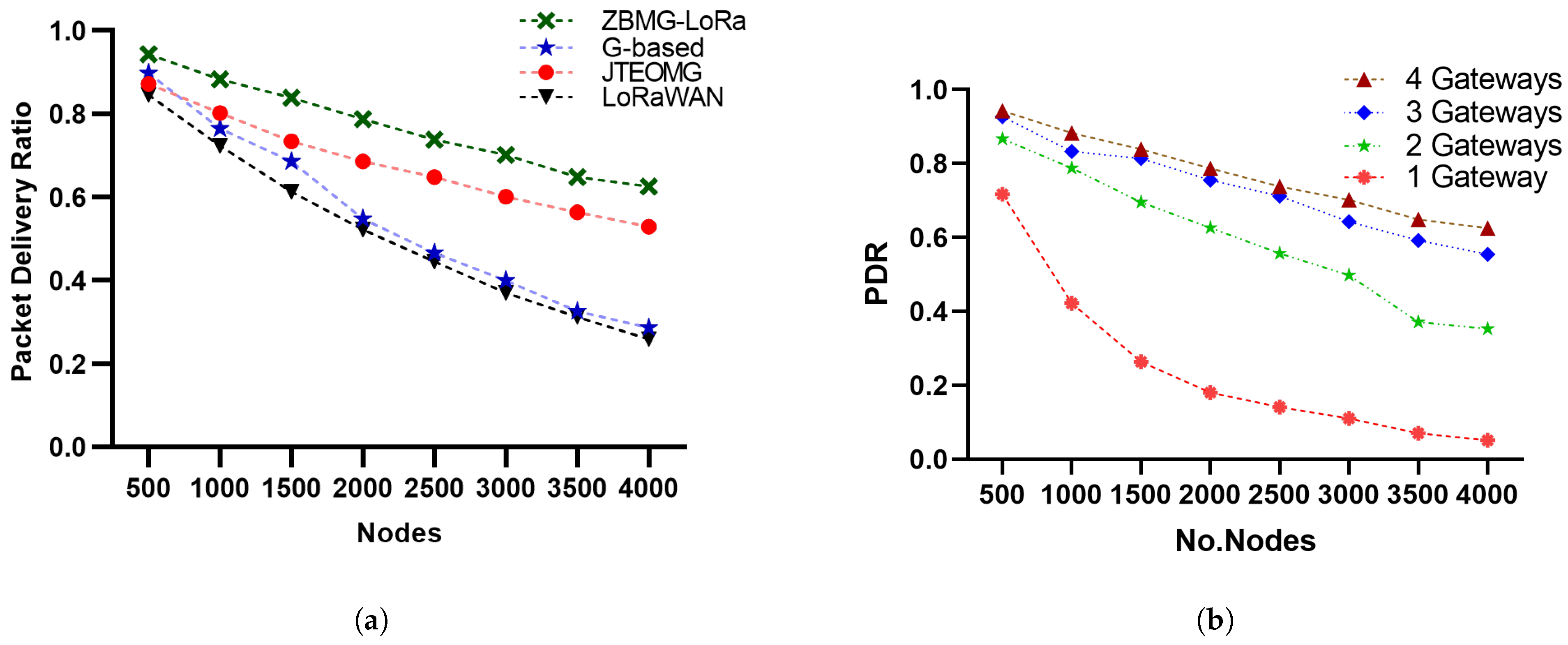
5.2. Throughput
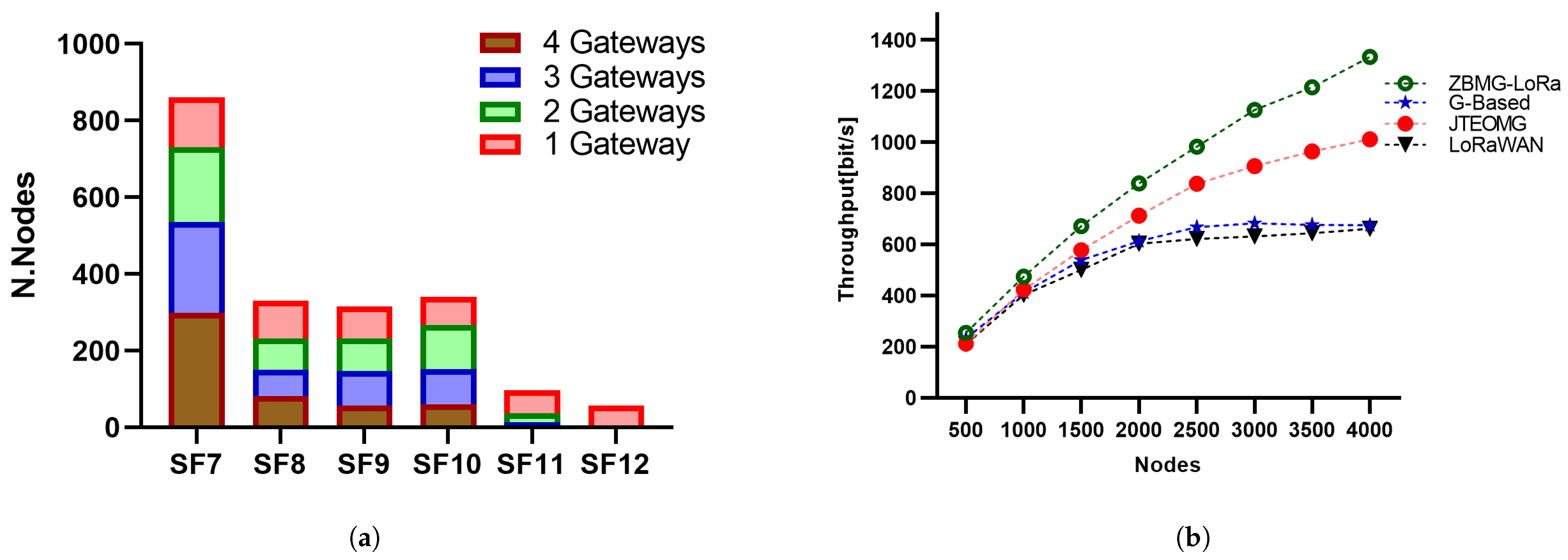
5.3. Energy Consumption
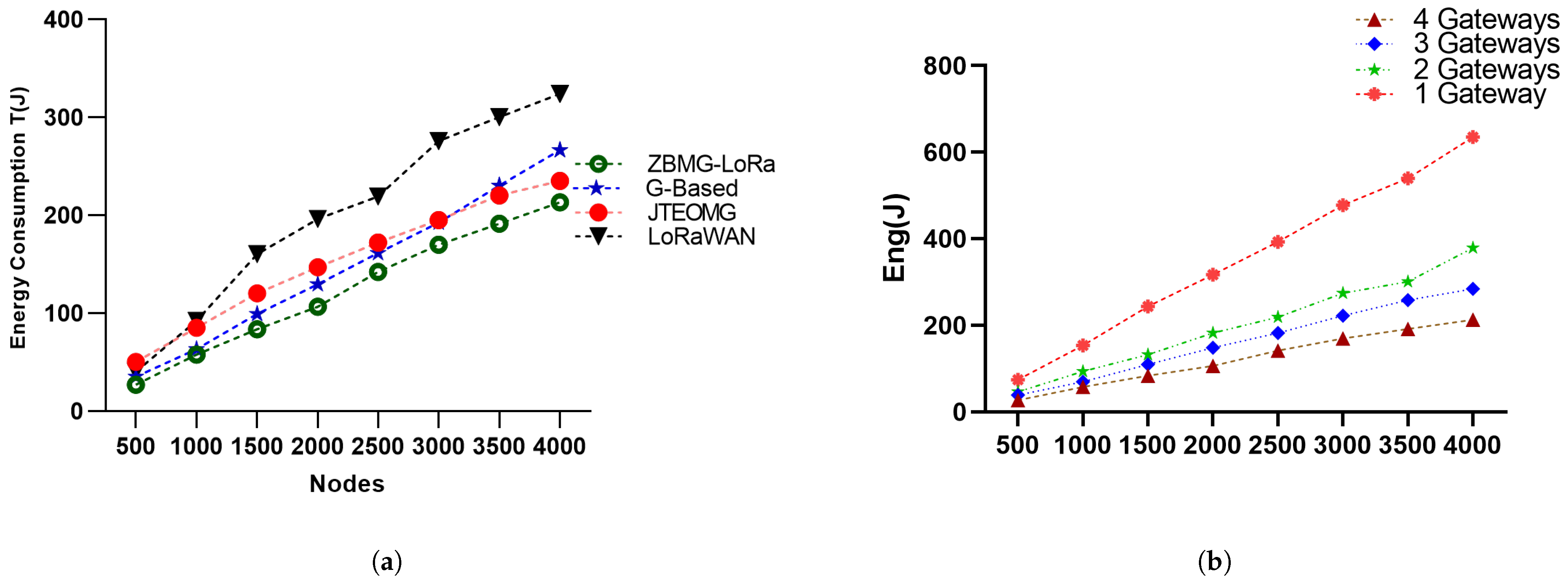
6. Conclusions
Author Contributions
Funding
Institutional Review Board Statement
Informed Consent Statement
Data Availability Statement
Acknowledgments
Conflicts of Interest
References
- Raza, U.; Kulkarni, P.; Sooriyabandara, M. Low Power Wide Area Networks: An Overview. IEEE Commun. Surv. Tutor. 2017, 19, 855–873. [Google Scholar] [CrossRef]
- Marini, R.; Mikhaylov, K.; Pasolini, G.; Buratti, C. LoRaWANSim: A Flexible Simulator for LoRaWAN Networks. Sensors 2021, 21, 695. [Google Scholar] [CrossRef] [PubMed]
- Ma, H.; Tao, Y.; Fang, Y.; Chen, P.; Li, Y. Multi-Carrier Initial-Condition-Index-aided DCSK Scheme: An Efficient Solution for Multipath Fading Channel. IEEE Trans. Veh. Technol. 2025, 1–14. [Google Scholar] [CrossRef]
- Vangelista, L. Frequency shift chirp modulation: The LoRa modulation. IEEE Signal Process. Lett. 2017, 24, 1818–1821. [Google Scholar] [CrossRef]
- Almuhaya, M.; Al-Hadhrami, T.; Kaiwartya, O.; Brown, D.J. A Novel Fair Frame Time Slot LoRaWAN Internet of Things. In Proceedings of the 2024 International Conference on Intelligent Computing and Next Generation Networks (ICNGN), Bangkok, Thailand, 23–25 November 2024. [Google Scholar] [CrossRef]
- Almuhaya, M.; Al-Hadhrami, T.; Kaiwartya, O.; Brown, D.J. A Comprehensive Comparison in Time-Slotted Frame Protocols in LoRaWAN IoT Technology. In Proceedings of the 2023 IEEE Smart World Congress (SWC), Portsmouth, UK, 28–31 August 2023. [Google Scholar] [CrossRef]
- Mastilovic, A.; Vukobratovic, D.; Jakovetic, D.; Bajovic, D. Cooperative Slotted ALOHA for massive M2M random access using directional antennas. In Proceedings of the 2017 IEEE International Conference on Communications Workshops (ICC Workshops), Paris, France, 21–25 May 2017; pp. 731–736. [Google Scholar] [CrossRef]
- Yegin, A.O. LoRaWAN Specication v1.0.4. 2020. Available online: https://www.lora-alliance.org/technology (accessed on 29 April 2025).
- Xanthopoulos, A.; Valkanis, A.; Beletsioti, G.; Papadimitriou, G.I.; Nicopolitidis, P. On the Use of Backoff Algorithms in Slotted ALOHA LoRaWAN Networks. In Proceedings of the 2020 International Conference on Computer, Information and Telecommunication Systems (CITS), Hangzhou, China, 5–7 October 2020. [Google Scholar] [CrossRef]
- Yang, Y.; Dai, L. Stability Region and Transmission Control of Multi-Cell Aloha Networks. IEEE Trans. Commun. 2023, 71, 5348–5364. [Google Scholar] [CrossRef]
- Petroni, A.; Biagi, M. Interference Mitigation and Decoding Through Gateway Diversity in LoRaWAN. IEEE Trans. Wirel. Commun. 2022, 21, 9068–9081. [Google Scholar] [CrossRef]
- Ding, J.; Qu, D.; Liu, P.; Choi, J. Machine Learning Enabled Preamble Collision Resolution in Distributed Massive MIMO. IEEE Trans. Commun. 2021, 69, 2317–2330. [Google Scholar] [CrossRef]
- Loubany, A.; Lahoud, S.; Samhat, A.E.; El Helou, M. Joint throughput-energy optimization in multi-gateway LoRaWAN networks. Telecommun. Syst. 2023, 84, 271–283. [Google Scholar] [CrossRef]
- Lee, J.; Jeong, W.C.; Choi, B.C. A Scheduling Algorithm for Improving Scalability of LoRaWAN. In Proceedings of the 2018 International Conference on Information and Communication Technology Convergence (ICTC), Jeju, Republic of Korea, 17–19 October 2018. [Google Scholar] [CrossRef]
- Cuomo, F.; Campo, M.; Caponi, A.; Bianchi, G.; Rossini, G.; Pisani, P. EXPLoRa: Extending the performance of LoRa by suitable spreading factor allocations. In Proceedings of the 2017 IEEE 13th International Conference on Wireless and Mobile Computing, Networking and Communications (WiMob), Rome, Italy, 9–11 October 2017. [Google Scholar] [CrossRef]
- Georgiou, O.; Raza, U. Low Power Wide Area Network Analysis: Can LoRa Scale? IEEE Wirel. Commun. Lett. 2017, 6, 162–165. [Google Scholar] [CrossRef]
- Cuomo, F.; Campo, M.; Bassetti, E.; Cartella, L.; Sole, F.; Bianchi, G. Adaptive mitigation of the Air-Time pressure in LoRa multi-gateway architectures. In Proceedings of the European Wireless 2018—24th European Wireless Conference, Catania, Italy, 2–4 May 2018; pp. 1–6. [Google Scholar]
- Sallum, E.; Pereira, N.; Alves, M.; Santos, M. Improving Quality-Of-Service in LoRa Low-Power Wide-Area Networks through Optimized Radio Resource Management. J. Sens. Actuator Netw. 2020, 9, 10. [Google Scholar] [CrossRef]
- Narieda, S.; Fujii, T.; Umebayashi, K. Energy Constrained Optimization for Spreading Factor Allocation in LoRaWAN. Sensors 2020, 20, 4417. [Google Scholar] [CrossRef] [PubMed]
- Loubany, A.; Lahoud, S.; El Chall, R. Adaptive algorithm for spreading factor selection in LoRaWAN networks with multiple gateways. Comput. Netw. 2020, 182, 107491. [Google Scholar] [CrossRef]
- Islam, M.R.; Bokhtiar-Al-Zami, M.; Paul, B.; Palit, R.; Grégoire, J.C.; Islam, S. Interference issues in LoRaWAN: A comparative study using simulator and analytical model. In Proceedings of the 2022 IEEE Region 10 Symposium (TENSYMP), Montreal, QC, Canada, 8–13 October 2017; pp. 1–6. [Google Scholar] [CrossRef]
- Chen, M.; Mokdad, L.; Ben-Othman, J.; Fourneau, J.M. Dynamic Parameter Allocation With Reinforcement Learning for LoRaWAN. IEEE Internet Things J. 2023, 10, 10250–10265. [Google Scholar] [CrossRef]
- Mahmood, A.; Sisinni, E.; Guntupalli, L.; Rondon, R.; Hassan, S.A.; Gidlund, M. Scalability Analysis of a LoRa Network Under Imperfect Orthogonality. IEEE Trans. Ind. Inform. 2019, 15, 1425–1436. [Google Scholar] [CrossRef]
- Bankov, D.; Khorov, E.; Lyakhov, A. Mathematical Model of LoRaWAN Channel Access with Capture Effect. In Proceedings of the 2017 IEEE 28th Annual International Symposium on Personal, Indoor, and Mobile Radio Communications (PIMRC), Montreal, QC, Canada, 8–13 October 2017. [Google Scholar]
- El Korbi, I.; Ghamri-Doudane, Y.; Saidane, L.A. LoRaWAN Analysis under Unsaturated Traffic, Orthogonal and non-Orthogonal Spreading Factor Conditions. In Proceedings of the 2018 IEEE 17th International Symposium on Network Computing and Applications (NCA), Cambridge, MA, USA, 1–3 November 2018. [Google Scholar]
- Loubany, A.; Lahoud, S.; Samhat, A.E.; Helou, M.E. Throughput Improvement for LoRaWAN Networks Considering IoT Applications Priority. In Proceedings of the 2023 6th Conference on Cloud and Internet of Things (CIoT), Lisbon, Portugal, 20–22 March 2023; pp. 206–210. [Google Scholar] [CrossRef]
- Ochoa, M.N.; Maman, M.; Duda, A. Spreading Factor Allocation for LoRa Nodes Progressively Joining a Multi-Gateway Adaptive Network. In Proceedings of the GLOBECOM 2020–2020 IEEE Global Communications Conference, Taipei, Taiwan, 7–11 December 2020; pp. 1–6. [Google Scholar] [CrossRef]
- Marini, R.; Cuozzo, G. A comparative performance analysis of LoRaWAN in two frequency spectra: EU868 MHz and 2.4 GHz. In Proceedings of the 2023 Joint European Conference on Networks and Communications & 6G Summit (EuCNC/6G Summit), Gothenburg, Sweden, 6–9 June 2023; pp. 1–6. [Google Scholar] [CrossRef]
- Sisinni, E.; Depari, A.; Bellagente, P.; Flammini, A.; Silva, I.; Flores, T.; Ferrari, P. Can adaptive strategies sustain bidirectional LoRaWAN traffic? In Proceedings of the 2023 IEEE International Workshop on Metrology for Industry 4.0 & IoT (MetroInd 4.0 & IoT), Brescia, Italy, 6–8 June 2023; pp. 66–71. [Google Scholar] [CrossRef]
- Javed, S.; Zorbas, D. Downlink Traffic Demand-Based Gateway Activation in LoRaWAN. In Proceedings of the 2023 IEEE Symposium on Computers and Communications (ISCC), Gammarth, Tunisia, 9–12 July 2023. [Google Scholar]
- Dongare, A.; Narayanan, R.; Gadre, A.; Luong, A.; Balanuta, A.; Kumar, S.; Iannucci, B.; Rowe, A. Charm: Exploiting Geographical Diversity through Coherent Combining in Low-Power Wide-Area Networks. In Proceedings of the 2018 17th ACM/IEEE International Conference on Information Processing in Sensor Networks (IPSN), Porto, Portugal, 11–13 April 2018; pp. 60–71. [Google Scholar] [CrossRef]
- Heusse, M.; Caillouet, C.; Duda, A. Performance of Unslotted ALOHA with Capture and Multiple Collisions in LoRaWAN. IEEE Internet Things J. 2023, 10, 17824–17838. [Google Scholar] [CrossRef]
- Georgiou, O.; Psomas, C.; Krikidis, I. Coverage Scalability Analysis of Multi-Cell LoRa Networks. In Proceedings of the ICC 2020—2020 IEEE International Conference on Communications (ICC), Dublin, Ireland, 7–11 June 2020. [Google Scholar] [CrossRef]
- Bouazizi, Y.; Benkhelifa, F.; McCann, J. Spatiotemporal Modelling of Multi-Gateway LoRa Networks with Imperfect SF Orthogonality. In Proceedings of the GLOBECOM 2020—2020 IEEE Global Communications Conference, Taipei, Taiwan, 7–11 December 2020; pp. 1–7. [Google Scholar] [CrossRef]
- Reynders, B.; Pollin, S. Chirp spread spectrum as a modulation technique for long range communication. In Proceedings of the 2016 Symposium on Communications and Vehicular Technologies (SCVT), Mons, Belgium, 22 November 2016; pp. 1–5. [Google Scholar] [CrossRef]
- Sun, Z.; Yang, H.; Liu, K.; Yin, Z.; Li, Z.; Xu, W. Recent Advances in LoRa: A Comprehensive Survey. ACM Trans. Sens. Netw. 2022, 18, 1–44. [Google Scholar] [CrossRef]
- Ullah, M.A.; Pasolini, G.; Mikhaylov, K.; Alves, H. Understanding the Limits of LoRa Direct-to-Satellite: The Doppler Perspectives. IEEE Open J. Commun. Soc. 2023, 5, 51–63. [Google Scholar] [CrossRef]
- Gao, H.; Huang, Z.; Zhang, X.; Huang, L. Design of LoRa Communication Protocol for Image Transmission. In Proceedings of the 2023 8th International Conference on Intelligent Computing and Signal Processing (ICSP), Xi’an, China, 21–23 April 2023; pp. 2142–2146. [Google Scholar] [CrossRef]
- Rappaport, T. Wireless Communications: Principles and Practice; Prentice Hall Communications Engineering and Emerging Technologies Series; Prentice Hall: Saddle River, NJ, USA, 2002. [Google Scholar]
- Bor, M.; Roedig, U.; Voigt, T.; Alonso, J. Do LoRa Low-Power Wide-Area Networks Scale? In Proceedings of the MSWiM ’16: Proceedings of the 19th ACM International Conference on Modeling, Analysis and Simulation of Wireless and Mobile Systems, Floriana, Malta, 13–17 November 2016. [Google Scholar] [CrossRef]
- Slabicki, M.; Premsankar, G.; Francesco, M.D. Adaptive configuration of lora networks for dense IoT deployments. In Proceedings of the NOMS 2018—2018 IEEE/IFIP Network Operations and Management Symposium, Taipei, Taiwan, 23–27 April 2018; pp. 1–9. [Google Scholar] [CrossRef]
- Petajajarvi, J.; Pettissalo, M.; Mikhaylov, K.; Roivainen, A.; Hänninen, T. On the Coverage of LPWANs: Range Evaluation and Channel Attenuation Model for LoRa Technology. In Proceedings of the 2015 14th International Conference on ITS Telecommunications (ITST), Copenhagen, Denmark, 2–4 December 2015. [Google Scholar] [CrossRef]
- Confidential, Semtech. Proprietary. Long Range, Low Power, Multi-Band LoRa® Transceiver. 2023. Available online: https://www.semtech.com/products/wireless-rf/lora-connect/lr1121 (accessed on 29 April 2025).
- Almuhaya, M.; Al-Hadhrami, T.; Kaiwartya, O.; Brown, D.J. MBMD-LoRa Scalable LoRaWAN for Internet of Things: A Multi-band Multi-data Rate Approach. In Proceedings of the Advances in Computational Collective Intelligence, Tokyo, Japan, 14–16 June 2024; Nguyen, N.T., Franczyk, B., Ludwig, A., Nunez, M., Treur, J., Vossen, G., Kozierkiewicz, A., Eds.; Springer Nature: Cham, Switzerland, 2024; pp. 54–67. [Google Scholar]
- Reynders, B.; Meert, W.; Pollin, S. Power and spreading factor control in low power wide area networks. In Proceedings of the 2017 IEEE International Conference on Communications (ICC), Paris, France, 21–25 May 2017. [Google Scholar] [CrossRef]
- Semtech Corporation. LoRaWAN Simple Rate Adaption Recommended Algorithm; Semtech: Camarillo, CA, USA, 2016. [Google Scholar]
- Seller, O.; Yegin, A. RP002-1.0.1 LoRaWAN® Regional Parameters. 2020. Available online: https://lora-alliance.org/wp-content/uploads/2020/11/rp_2-1.0.1.pdf (accessed on 29 April 2025).
- Al-Gumaei, Y.A.; Aslam, N.; Chen, X.; Raza, M.; Ansari, R.I. Optimizing Power Allocation in LoRaWAN IoT Applications. IEEE Internet Things J. 2022, 9, 3429–3442. [Google Scholar] [CrossRef]
- De Jesus, G.G.M.; Souza, R.D.; Montez, C.; Hoeller, A. LoRaWAN Adaptive Data Rate with Flexible Link Margin. IEEE Internet Things J. 2021, 8, 6053–6061. [Google Scholar] [CrossRef]
| Parameter | Value | Comments |
|---|---|---|
| N | 500 → 4000 | Nodes in network |
| GW | 1 → 4 | Gateways |
| f | 7 → 12 | Spreading factors |
| 1000 m | initial distance | |
| 2.32 dBm | PLoss exponent | |
| 128.95 | Ploss of initial distance | |
| 2 → 14 dBm | Transmission Power | |
| 4/5 | Coding Rate | |
| b | 125 kHz | Bandwidth |
| Area | 7000 m2 | Field Area |
| CF | [860, 864, 868] | Carrier Frequency (MHz) |
| T(s) | One day | Simulation time |
| 10 min | Round time |
Disclaimer/Publisher’s Note: The statements, opinions and data contained in all publications are solely those of the individual author(s) and contributor(s) and not of MDPI and/or the editor(s). MDPI and/or the editor(s) disclaim responsibility for any injury to people or property resulting from any ideas, methods, instructions or products referred to in the content. |
© 2025 by the authors. Licensee MDPI, Basel, Switzerland. This article is an open access article distributed under the terms and conditions of the Creative Commons Attribution (CC BY) license (https://creativecommons.org/licenses/by/4.0/).
Share and Cite
Almuhaya, M.; Al-Hadhrami, T.; Brown, D.J.; Qasem, S.N. ZBMG-LoRa: A Novel Zone-Based Multi-Gateway Approach Towards Scalable LoRaWANs for Internet of Things. Sensors 2025, 25, 5457. https://doi.org/10.3390/s25175457
Almuhaya M, Al-Hadhrami T, Brown DJ, Qasem SN. ZBMG-LoRa: A Novel Zone-Based Multi-Gateway Approach Towards Scalable LoRaWANs for Internet of Things. Sensors. 2025; 25(17):5457. https://doi.org/10.3390/s25175457
Chicago/Turabian StyleAlmuhaya, Mukarram, Tawfik Al-Hadhrami, David J. Brown, and Sultan Noman Qasem. 2025. "ZBMG-LoRa: A Novel Zone-Based Multi-Gateway Approach Towards Scalable LoRaWANs for Internet of Things" Sensors 25, no. 17: 5457. https://doi.org/10.3390/s25175457
APA StyleAlmuhaya, M., Al-Hadhrami, T., Brown, D. J., & Qasem, S. N. (2025). ZBMG-LoRa: A Novel Zone-Based Multi-Gateway Approach Towards Scalable LoRaWANs for Internet of Things. Sensors, 25(17), 5457. https://doi.org/10.3390/s25175457









